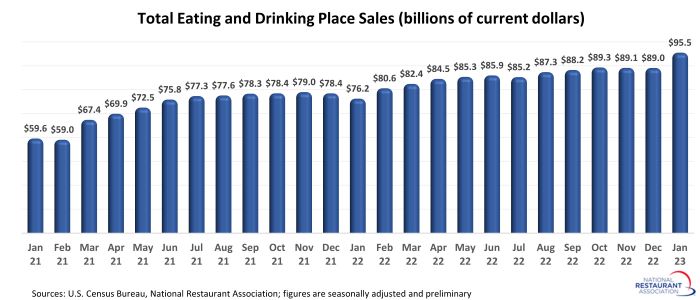Consumer spending continued to rise in January
Eating and drinking places* registered total sales of $95.5 billion on a seasonally adjusted basis in January, according to preliminary data from the U.S. Census Bureau. That was up significantly from sales volumes of roughly $89 billion in both November and December.
January’s lofty seasonally-adjusted sales reading was flattered somewhat by atypical seasonal trends. In unadjusted terms, eating and drinking place sales declined 4.4% between December 2022 and January 2023. That was only about half of the ‘normal’ December-to-January sales decline. Between 2017 and 2020, January’s unadjusted sales volume was 8.7% below the previous December’s level, on average.
When seasonal factors are applied to an unusually elevated unadjusted sales figure, the result can often be a seasonally-adjusted number that appears inconsistent with the existing trend.
Looking beyond the statistical quirks, January was still a positive sales month for the restaurant industry. In unadjusted terms, January’s preliminary sales volume stood 24% above the January 2022 reading – a month that saw business conditions negatively impacted by the omicron variant.
Moving forward, consumers are expected to remain resilient in the coming months, even in the face of an economy that is likely to slow. Healthy household balance sheets, a buoyant labor market and moderating inflation will give consumers the wherewithal to continue burning off the pent-up demand that they accumulated during the pandemic.

*Eating and drinking places are the primary component of the U.S. restaurant and foodservice industry, which prior to the coronavirus pandemic generated approximately 75 percent of total restaurant and foodservice sales. Monthly sales figures presented above represent total revenues at all eating and drinking place establishments.
Read more analysis and commentary from the Association's chief economist Bruce Grindy.